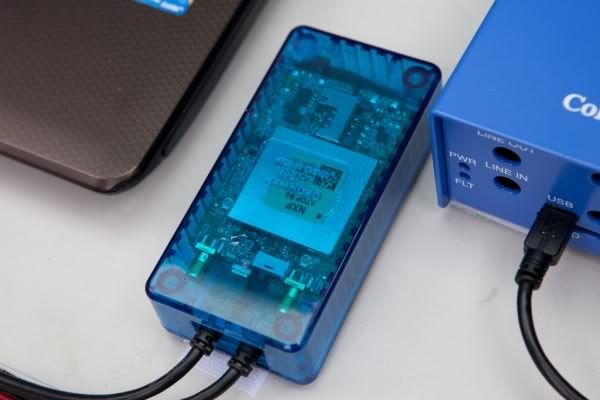
The first standardized and hardware platform for peer-to-peer automobile communication called C2X, the module inside is the product of Choda Wireless and near-field communications at NXP, and it uses 802.11 Wi-Fi to let equipped cars see another around blind corners, through other vehicles, chat with traffic signals up to a mile away. Pocket-lint got a look at the technology during Automotive week, and its a good idea of when we expect the tech; NXP says it will begin rolling out in 2014 and hopes every cars will get it by 2020. For more details read the press release.
Here is the Press Release
NXP Demonstrates New car-to-x Communication Platform: Major Milestone Towards Safer Road Traffic
EINDHOVEN, NETHERLANDS–(Marketwire – May 17, 2011) – NXP Semiconductors N.V. (NASDAQ: NXPI) today gave a live demonstration of car-to-x (C2X) communication on a public road in the Netherlands. With this demo, NXP is the first semiconductor company to take the step from showing concepts to actually demonstrating an automotive-ready hardware platform for connected mobility. NXP has co-developed the C2X platform with Australian-based Cohda Wireless. Combined with telematics for location-based services and networking security, the platform enables the fully connected car and is therefore a major milestone towards mass deployment for safer road traffic.
C2X communication uses IEEE802.11p, a wireless standard designed specifically for automotive applications. This allows cars to communicate with each other (car-to-car) as well as with intelligent traffic infrastructure (car-to-infrastructure) around them. The newly developed C2X platform from NXP and Cohda actually “sees” around corners in order to recognize traffic blocks or risks before they are visible to the human eye. Drivers therefore receive early warnings of cars hidden from sight behind trucks or approaching from around corners. Other use cases are warnings about emergency vehicles and traffic jams, or traffic light signals allowing drivers to adjust their speed and optimize driving.
The C2X platform is able to meet the requirements of the automotive industry: reliable signal reception for fast-moving objects even in difficult surroundings, cost-efficient design, and flexible programming. It uses Cohda’s Advanced IEEE 802.11p radio and is based on NXP’s multi-standard radio reception platform. NXP’s expertise as a global leader in car entertainment semiconductors and Cohda’s patented reception algorithms are critical factors for successful development.
The C2X demo is one of several connected mobility demos which NXP is presenting during Automotive Week 2011, from May 14 to 22, 2011 in Eindhoven, Netherlands. As project leader of the Dutch SPITS research project (SPITS: Strategic Platform for Intelligent Transport Systems), NXP is a major contributor to Automotive Week. For a whole week the Brainport Region is the international stage for the latest technological developments in the automotive field. Industry, Dutch government and research institutes are joining forces with the theme of “Building the Future in Mobility.” Other demonstrations from NXP at Automotive Week 2011 include intelligent traffic data analysis from the in-vehicle networks, as well as emergency and breakdown calls based on NXP’s telematics module, ATOP.
Kurt Sievers, senior vice president and general manager of the Automotive business at NXP Semiconductors, explains: “Connecting the car to the environment demands in-depth expertise in secure connectivity, Software-Defined Radio architectures, and telematics. These technologies are at the very heart of NXP’s automotive portfolio. NXP has therefore set a high priority on gaining the pole position in connected mobility. The SPITS project has been extremely valuable for us as it brought experts and research partners from all parts of the value chain together all working towards the same goal: efficient and sustainable mobility solutions.”
For more information, please visit:our Automotive Week event page:
www.nxp.com/spits
www.automotiveweek.nl
About SPITS project
SPITS stands for Strategic Platform for Intelligent Transport Systems. SPITS is about ensuring that mobility become more efficient and sustainable. It focuses on three main areas: traffic management and safety, concepts for open in-car platform, and downloadable services. SPITS was aimed at creating an open and affordable intelligent transport system platform, which is scalable, secure and real-time. The Dutch Ministry of Economic Affairs has subsidised the project. The consortium is lead by NXP Semiconductors and consists of eight companies (NXP, TomTom, TNO, Logica, Catena, Task24, Foutress, GreenCat), one research institute, and four universities. These partners cover the entire mobility value chain, enabling the complete development of all elements necessary in the system. The SPITS project has involved two years of innovative thinking, close cooperation between organisations, and the construction of prototypes to prove the validity of the system. The SPITS system comprises the vehicle on-board unit (OBU), the Road Side Unit (RSU) infrastructure, and the Back Office (BO) service centre. Communications between these elements is a major part of the Strategic Platform. After the SPITS project officially ends, consortium members will continue to refine the SPITS results for commercial use across Europe and beyond. These projects represent an investment by the Government to retain key knowledge from R&D companies within the Netherlands, following the economic crisis.
About NXP Semiconductors
NXP Semiconductors N.V. (NASDAQ: NXPI) provides High Performance Mixed Signal and Standard Product solutions that leverage its leading RF, Analog, Power Management, Interface, Security and Digital Processing expertise. These innovations are used in a wide range of automotive, identification, wireless infrastructure, lighting, industrial, mobile, consumer and computing applications. A global semiconductor company with operations in more than 25 countries, NXP posted revenue of $4.4 billion in 2010. Additional information can be found by visiting www.nxp.com.
